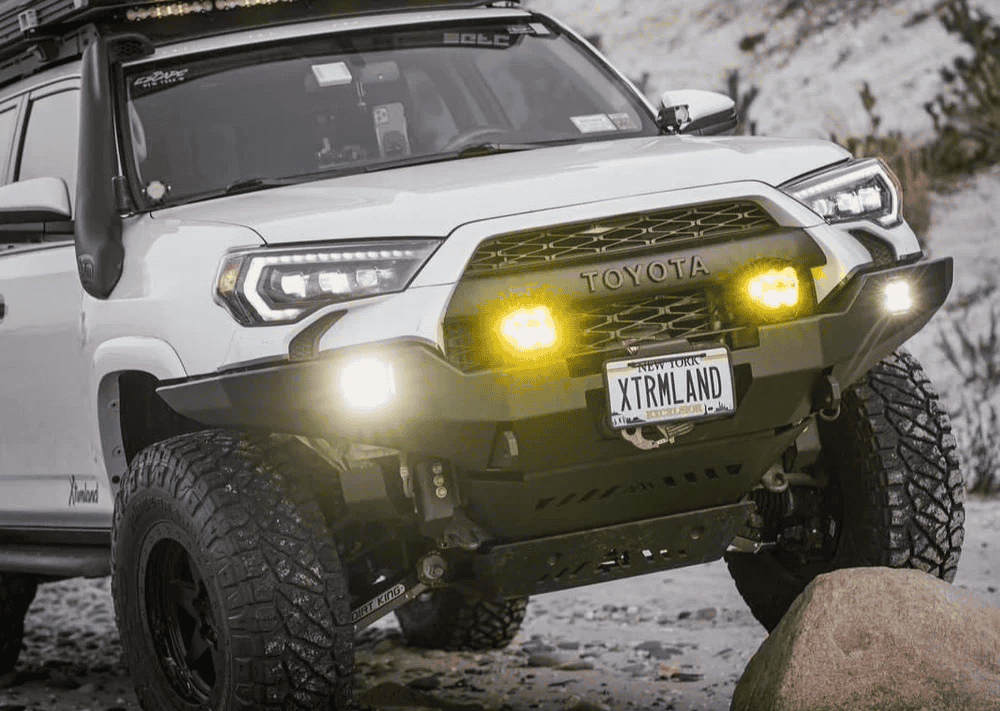Overland Vehicles

The Overland F450 sits in a league of its own for payload and stability. Built on a commercial grade foundation, it uses a wide track front axle, stout frame sections, and high capacity brakes designed to manage heavy loads over long distances. For overland travel with large slide in campers or custom flatbeds, that structure helps keep handling predictable when crosswinds, cambered forest roads, and long downhill grades stack up.
Most F450 platforms arrive with 19.5 inch wheels, tight steering geometry, and deep axle ratios that help with control and cooling when weight and grade combine. The tradeoff is size. A wider track and broader mirrors can limit access to tight timber roads and narrow switchbacks. Approach and departure angles improve with front and rear bumpers built for clearance, but a long wheelbase still requires thoughtful line choice.
Tire strategy is central. Many owners move to super single conversions to reduce rear duals into one robust tire per side. This simplifies spares, increases flotation on sand and snow, and opens the door for larger diameters. A properly tuned suspension with quality shocks and progressive springs handles the extra unsprung mass and keeps the body composed on corrugations. Braking and cooling maintenance schedules should be treated as trip critical, not optional.
Axle ratios like 4.30 or deeper are common on F450 platforms and pair well with larger tires and significant camper weight. Locking differentials or limited slip units improve traction on off camber climbs and loose surfaces. For highway sections, correct gearing reduces trans heat, keeps the turbo in its efficiency range on diesel models, and preserves range.
The F250 Overland path shines when the terrain narrows and payload demands stay moderate. It offers a lighter curb weight, easier parking, and a tighter footprint on technical trails. With a canopy camper, bed rack, or lightweight slide in, the F250 can carry essentials without overwhelming the axle ratings. Tire sizing to 35 or 37 inches, matched with steering and braking upgrades, nets meaningful ground clearance without turning the truck into a handful.
Where the Overland F450 feels like an interstate mile eater that shrugs off headwinds and heavy builds, the F250 feels nimble. It threads through forest gates, squeezes past washouts, and is less punishing on rough two tracks. That said, payload discipline matters. Armor, water, extra fuel, a winch, and tools add up quickly. Smart packing and weight distribution keep handling crisp and reduce the risk of bottoming on ledges.
Wheelbase influences breakover angle and turning radius. The F450’s wide track front axle delivers an impressively tight circle for its size, helpful in trailhead U turns. Shorter wheelbase F250 configurations still hold the edge in tight rock gardens and switchbacks, especially with careful tire placement and appropriate sway bar tuning.
No matter the badge, a Super Duty overland build lives or dies by its supporting systems. Suspension should match weight, not just lift height. Pair quality coil or leaf solutions with properly valved shocks and add hydraulic bump stops if you often meet sharp ledges. Armor should prioritize clearance and protection at the approach, belly, and departure zones while keeping weight as low as possible. Skid plate coverage for engine, transmission, and transfer case is cheap insurance far from service.
Recovery planning is more than a winch. Factor in soft shackles, rated recovery points, a long static rope, boards, and onboard air to reseat beads and adjust pressures for changing surfaces. Brakes and cooling deserve attention on descents with a built truck. On the power side, diesel 6.7 platforms deliver torque and engine braking benefits with proper maintenance of emissions components, while the 7.3 gas route offers simplicity and cold weather friendliness at the cost of range. Auxiliary fuel tanks, bed mounted water, and a tidy electrical system with a DC to DC charger keep fridges, lights, and comms online for extended stays.
Select tire size first, then gear the truck to maintain a useful highway rpm under load. Add an auxiliary tank only after optimizing weight and aerodynamics, since drag and roof height can drain range faster than most expect. Keep electrical loads efficient with LED lighting and a compact inverter for tools and chargers.
If you are eyeing a heavy camper on an Overland F450 or a nimble F250 Overland setup, a thoughtful plan will save money and headaches. Explore our approach on the Overland Rigs page at Overland Rigs. See how a full package comes together on Custom Overland Upfit. Learn what sets our process apart on Why Choose OZK Customs. Share your travel style and payload goals, and we will dial the suspension, armor, power, and storage to fit the miles you want to drive.
Ready to turn your Super Duty into a reliable overland rig? Tell us how you travel, the gear you carry, and the terrain you chase. We will spec the right suspension, armor, power, and layout to match your goals and timeline. Submit the form and we will map your build from day one.
ADDRESS:
6159 E Huntsville Rd, Fayetteville, AR 72701
PHONE:
(479) 326-9200
EMAIL:
info@ozkvans.com